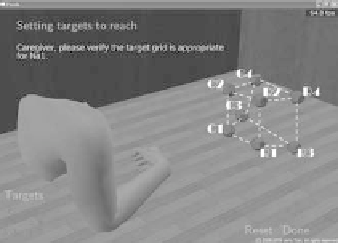Biomedical Engineering Reference
In-Depth Information
(a)
(b)
Figure 2.5
Screen-shot of the virtual reality environment of the biofeedback interface (a)
Screen short of subject performing a reaching task. (b) Screen-shot of the different targets
used to practice reaching tasks. For color reference, see page 211.
joint angles sensed by the robot, thus force the subject to move his/her arm to
achieve tasks in the virtual environment.
2.7 CLINICAL STUDY
The RUPERT system described above is currently being used in a small clinical
study to test the capability of the device for therapeutic use in a clinical envi-
ronment. The study consists of 12 stroke subjects who are at least 6-months post
stroke; the twelve subjects are divided into an experimental group and a control
group with 6 subjects each. The experimental group undergoes robot-assisted
therapy using RUPERT, and the control group practices exercises at home that are
prescribed by the therapist at the start of their course of therapy. Each subject in
the experimental group undergoes 12 therapy sessions (each session lasts for about
one hour) over a period of 4 weeks with 3 sessions per week. All subjects are
evaluated by another therapist that is blinded to the subject's group (experimental
or control). The evaluation is performed both pre- and post-therapy, and the
subjects are evaluated using the Fugl-Meyer Scale, the Wolf Motor Function Test,
the Stroke Impact Scale, and the Motor Activity Log.
The therapy protocol used for the experimental group follows the HIFUS
principle, where the therapy progresses from easy to difficult tasks. The therapy
tasks for the experimental group involves performing reaching movements to a
set of 8 targets, which are the combinations of different targets location at two
different reaching distances (Near and Far), two different reaching directions
(Center and Right), and two different reaching heights (Low and High) as shown
in
Fig. 2.5(b)
.
Each therapy session mainly consists of two types of movements,
voluntary movements, and robot-assisted movements with the robot functioning
in the co-operative mode. Each therapy session starts with the subject performing
voluntary reaching movements to these 8 targets. Based on their performance, the
targets that could not be reached by the subject voluntarily are ordered according


















